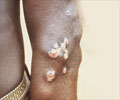- Adrian S. Bruce, Michael S. Loughnan ‘Anterior Eye and Therapeutics A-Z’
- R. Pitts Crick, Peng T. Khaw ‘A textbook of clinical ophthalmology’
About
Excess tearing may cause a sensation of watery eyes or result in tears falling down the cheek. Obstruction of tear drainage path can lead to stasis and is also a reason for watery eyes.
Lacrimation is watering of the eyes due to over production of tears by the lacrimal gland, whereas epiphora is watering due to impairment of the tear drainage system. The action of blinking provides a pumping mechanism for drainage of tears. Closure of the lids causes milking of the tears towards the puncta (opening for tear drainage located near the inner angles of the eyes). Following this, the eye muscles surrounding the eye occlude the puncta and force the tears into the tear sac. From the sac, the tears drain into the nose by gravity through a duct called the nasolacrimal duct.
Watering from the eyes can occur due to increased tear production or blockage of tear drainage.

Patients with watery eyes obviously have excessive watering. But alongside, they also complain of slight irritation and blurring of vision due to an excess tear film.
The following tests are used to diagnose problems in the tear drainage pathway: Dilatation & Irrigation (syringing), Johne’s dye test, Schirmer’s test, dacryocystogram and lacrimal scintillogram.
Watery eyes are managed conservatively by eye drops and massage over the nasolacrimal duct. Non resolving cases require surgical treatment like dacryocystorhinostomy (DCR), lid surgery or probing.












